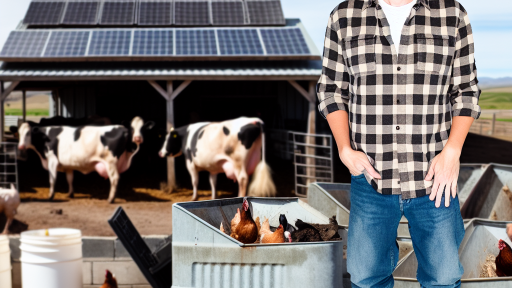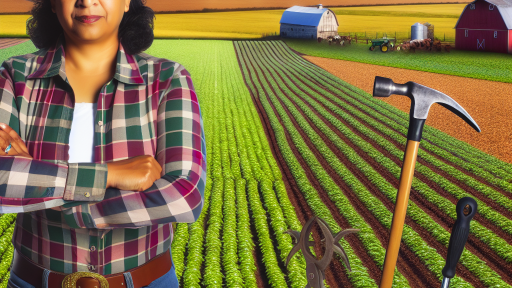Introduction to Cost Control Methods in Farming
Cost control methods are vital for sustainable farm financial health.
These strategies ensure that farms remain profitable over time.
Implemented effectively, they promote efficient resource usage.
Also, these methods reduce waste, benefiting both the farmer and the environment.
Understanding Cost Control
Cost control refers to managing expenses to maximize profits.
It requires careful planning and regular evaluation of spending.
Farmers set budgets to monitor costs effectively.
Moreover, by tracking expenditures, farmers can identify areas of savings.
Importance of Financial Health
Financial health is essential for any farming operation.
It underpins the ability to invest in growth and innovation.
Healthy finances ensure resilience during market fluctuations.
Additionally, it allows farmers to adapt to changing environmental conditions.
Key Components of Effective Cost Control
Several components contribute to effective cost control in farming.
- Detailed budgeting helps track all income and expenditures.
- Regular financial reviews provide insights into spending patterns.
- Technology integration improves efficiency and reduces labor costs.
- Supplier negotiations can lead to better pricing on inputs.
Strategies for Implementing Cost Control
Farmers can adopt various strategies to control costs effectively.
- Utilizing precision farming techniques enhances resource management.
- Emphasizing crop rotation improves soil health and sustainability.
- Investing in renewable energy sources can lower operational costs.
- Participating in cooperative buying groups leverages bulk purchasing.
Monitoring and Adjusting Costs
Consistent monitoring of costs is crucial for long-term success.
Transform Your Agribusiness
Unlock your farm's potential with expert advice tailored to your needs. Get actionable steps that drive real results.
Get StartedFarmers should regularly assess their financial performance.
Adjusting strategies based on performance outcomes ensures ongoing efficiency.
Continuous learning through workshops and research enhances skills.
Understanding the Importance of Sustainable Financial Health in Agriculture
Driving Economic Stability
Sustainable financial health ensures economic stability for farmers.
This stability protects against market fluctuations.
Consequently, farmers can maintain consistent cash flow.
Additionally, it allows for better investment in resources.
Promoting Environmental Responsibility
Sustainable practices enhance environmental conservation.
This includes responsible land use and resource management.
Farmers can reduce waste and pollution effectively.
Consequently, they preserve ecosystems for future generations.
Enhancing Community Resilience
Agricultural financial health impacts local communities.
Stronger farms lead to stronger local economies.
Furthermore, sustainable practices foster community engagement.
Communities benefit from local food systems and jobs.
Supporting Regulatory Compliance
Many regulations encourage sustainable farming methods.
Complying with these regulations promotes long-term viability.
Farmers can avoid fines or penalties through compliance.
Consequently, they sustain their operations more effectively.
Facilitating Access to Funding Opportunities
Sustainable financial practices open doors to funding.
Many institutions prefer lending to farmers with solid plans.
This access can help expand operations or improve facilities.
Thus, farmers can scale efficiently while maintaining sustainability.
Building Brand Value
Consumers increasingly prefer sustainable products.
Showcase Your Farming Business
Publish your professional farming services profile on our blog for a one-time fee of $200 and reach a dedicated audience of farmers and agribusiness owners.
Publish Your ProfileThis preference enhances brand value for farmers.
Consequently, they can command higher prices for their goods.
Sustainable practices translate to better market positioning.
Budgeting and Financial Planning for Farmers
The Importance of Budgeting
Budgeting is a critical tool for farmers aiming to maintain financial health.
It helps in planning for upcoming expenses and revenue streams.
Furthermore, effective budgeting enables farmers to set realistic financial goals.
By anticipating cash flow needs, farmers can make informed decisions.
Ultimately, budgeting supports long-term sustainability in operations.
Steps to Create a Farm Budget
Begin by gathering all financial data from previous years.
This includes income statements and expense reports.
Next, categorize expenses into fixed and variable costs.
Fixed costs remain constant, while variable costs fluctuate.
Then, project expected income based on crop yields and market prices.
Adjust your budget to account for seasonal variations in earnings.
Finally, review and revise your budget regularly for accuracy.
Using Technology for Budgeting
Farm management software offers tools to streamline budgeting processes.
Such programs help automate data collection and analysis.
Moreover, mobile apps allow farmers to track expenses on-the-go.
These technologies enhance accuracy and save time.
Overall, leveraging technology can improve financial planning efficiency.
Analyzing Budget Variances
Variance analysis helps farmers understand discrepancies in their budgets.
It compares actual performance against budgeted figures.
This analysis highlights areas needing attention or adjustment.
Additionally, regular reviews foster accountability and informed decision-making.
By identifying patterns, farmers can enhance future budgets.
Setting Financial Goals
Establishing clear financial goals is essential for successful farm management.
Short-term goals might include reducing unnecessary expenses.
Long-term goals could focus on expanding operations or acquiring new equipment.
Each goal should be Specific, Measurable, Achievable, Relevant, and Time-bound.
This approach creates a clear roadmap for financial improvement.
Implementing Cost Control Strategies
Cost control strategies help maintain profitability amidst fluctuating markets.
Identifying cost-saving opportunities is crucial for all farmers.
Consider negotiating with suppliers for better pricing on materials.
Additionally, explore opportunities to reduce waste in operations.
Regularly reviewing your budget ensures that you stay on track.
Furthermore, engaging employees in cost-saving initiatives can yield positive results.
You Might Also Like: Risk Management Strategies for Successful Farming
Implementing Efficient Resource Management Techniques
Assessing Current Resource Use
Effective resource management begins with assessing current usage.
Farmers should analyze their available inputs for efficiency.
Regular evaluations help identify wasteful practices.
Showcase Your Farming Business
Publish your professional farming services profile on our blog for a one-time fee of $200 and reach a dedicated audience of farmers and agribusiness owners.
Publish Your ProfileAdditionally, leverage technology to track resource consumption.
Adopting Sustainable Practices
Farmers must adopt sustainable practices to enhance productivity.
Crop rotation can improve soil health and reduce pests.
Integrating cover crops further helps prevent erosion.
Moreover, organic farming reduces the need for synthetic chemicals.
Utilizing Technology for Efficiency
Technology offers solutions for effective resource management.
Precision agriculture enables farmers to use resources wisely.
Drones and sensors can monitor crop health remotely.
Data analysis tools provide insights for better decision-making.
Training and Education
Ongoing education is essential for farmers.
Workshops on new techniques boost knowledge and skills.
Furthermore, connecting with peers fosters a learning environment.
Online resources can supplement hands-on training.
Engagement with Local Communities
Collaboration with local communities enhances resource management.
Farmers can share resources, reducing individual costs.
Cooperatives can support larger-scale purchases for bulk savings.
Finally, participating in local initiatives promotes sustainable practices.
Delve into the Subject: Best Practices in Farm Succession Strategies
Utilizing Technology for Cost Reduction and Efficiency
Implementing Precision Agriculture
Precision agriculture uses technology to enhance farming efficiency.
Farmers deploy GPS and sensor technology for real-time data collection.
This data guides decisions on resource allocation and crop management.
As a result, farmers can reduce waste and maximize yields.
Many farms experience significant cost savings through targeted applications.
Embracing Farm Management Software
Farm management software streamlines operations and financial tracking.
Farmers can access detailed reports on expenses and revenues anytime.
This software helps identify inefficiencies and areas for improvement.
Additionally, it allows for better planning and forecasting.
Integrating automated systems saves time and reduces human error.
Leveraging Drones for Monitoring
Drones offer a unique solution for monitoring large tracts of land.
These tools can quickly assess crop health and soil conditions.
Farmers can use aerial imagery to pinpoint problem areas efficiently.
Moreover, drones enhance the decision-making process for inputs.
This technology reduces labor costs associated with field inspections.
Utilizing IoT Devices for Smart Farming
The Internet of Things (IoT) transforms traditional farming practices.
Irrigation systems can operate based on real-time moisture data.
This automated approach conserves water and optimizes plant growth.
IoT devices also enhance livestock management by tracking health metrics.
Farmers can respond promptly to any changes, improving overall productivity.
Exploring Alternative Energy Solutions
Renewable energy sources can lower operational costs significantly.
Solar panels help farms reduce dependency on traditional electricity.
Showcase Your Farming Business
Publish your professional farming services profile on our blog for a one-time fee of $200 and reach a dedicated audience of farmers and agribusiness owners.
Publish Your ProfileWind turbines can also provide a sustainable energy alternative.
Investing in these systems leads to long-term financial benefits.
Moreover, it enhances the farm’s sustainability image to consumers.
Discover More: Implementing Drones for Crop Monitoring and Management
The Role of Crop Rotation and Diversification in Cost Control
Understanding Crop Rotation
Crop rotation involves changing the type of crop grown in a particular area over time.
This method benefits soil health and pest management.
Rotating crops helps to break pest cycles, reducing chemical inputs.
It also enhances soil structure and nutrient cycling.
Farmers can lower costs by improving their soil productivity.
Benefits of Diversification
Diversification adds variety to farm operations and crop types.
This strategy helps in managing market risks effectively.
It reduces dependence on a single crop, increasing financial stability.
Farmers can explore different market opportunities through diversification.
Financial Implications of Crop Rotation and Diversification
Implementing crop rotation and diversification can lead to significant cost savings.
Farmers can decrease their reliance on costly fertilizers and pesticides.
These methods enhance resilience against market fluctuations and climate change.
Long-term sustainability improves overall farm profitability.
Implementing These Techniques
Farmers can start by evaluating their current crop systems and soil health.
They should create a crop plan that includes diverse species.
Utilizing cover crops can further promote soil health and biodiversity.
Engaging with local agricultural extension services can provide valuable insights.
Networking with other farmers can help share experiences and success stories.
Challenges in Adoption
One challenge is the initial learning curve related to new practices.
Farmers may face resistance to change from traditional methods.
Additionally, some may struggle with the upfront investment for new crops.
However, the long-term benefits often outweigh these initial challenges.
You Might Also Like: Strategic Alliances In Modern Sustainable Agriculture

Analyzing and Reducing Labor Costs on the Farm
Understanding Labor Costs
Labor costs significantly impact a farm’s overall budget.
Farmers must analyze these expenses to improve profitability.
Understanding labor categories helps identify areas for reduction.
Identifying Key Areas for Improvement
Begin by evaluating tasks and hours worked on the farm.
Creating a detailed labor audit is essential for this analysis.
Common areas for improvement include overtime pay and seasonal staffing.
Implementing Technology Solutions
Leveraging technology can streamline labor-intensive processes.
Consider using automated systems for planting and harvesting.
Robotics can perform repetitive tasks efficiently and accurately.
Training and Development
Investing in employee training can enhance productivity levels.
Well-trained staff can work more effectively and with less oversight.
Training programs foster skill development and reduce errors.
Optimizing Labor Scheduling
Effective scheduling leads to better labor resource management.
Showcase Your Farming Business
Publish your professional farming services profile on our blog for a one-time fee of $200 and reach a dedicated audience of farmers and agribusiness owners.
Publish Your ProfileUtilize software for creating efficient work schedules.
Analyze peak labor times and adjust schedules accordingly.
Utilizing Alternative Labor Sources
Consider alternative labor sources, such as interns or seasonal workers.
Internships can provide fresh perspectives and lower costs.
Engaging local communities may also help meet short-term labor needs.
Exploring Labor Grants and Subsidies
Research potential grants and subsidies for labor costs.
Local government programs may offer financial assistance.
Applying for these can alleviate some financial burdens.
Monitoring and Reviewing Labor Costs
Consistent monitoring of labor costs ensures effective management.
Implement regular reviews to assess the effectiveness of changes.
Adjust strategies based on real-time data and feedback.
Evaluating Input Costs and Seeking Alternatives
Identifying Key Inputs
Farmers must first identify their main input costs.
These typically include seeds, fertilizers, fuel, and equipment.
Understanding these costs allows for better financial planning.
Conducting Regular Cost Analysis
Regularly analyze input costs to identify any significant changes.
Compare these costs against historical data to spot trends.
This practice helps in forecasting future expenditures.
Seeking Lower-Cost Alternatives
Explore alternative suppliers for critical inputs like seeds and fertilizers.
Negotiate with multiple vendors to secure the best prices.
Consider local sources as they might offer lower delivery costs.
Utilizing Crop Rotation and Diversification
Implement crop rotation to reduce dependency on specific inputs.
This method promotes soil health and can lower fertilizer needs.
Additionally, diversify crops to minimize risk and stabilize income.
Investing in Technology
Invest in precision agriculture technologies to optimize input use.
Utilizing technology can lead to more informed farming decisions.
Examples include soil sensors and automated irrigation systems.
Collaborating with Other Farmers
Collaborate with other farmers for bulk purchasing discounts.
This strategy often reduces costs significantly.
Form co-ops to leverage collective buying power for essentials.
Reviewing Financial Records
Regularly review financial records to identify unnecessary expenses.
Adjust the budget based on insights gained from financial analysis.
Continue refining your approach to ensure maximum cost efficiency.
Establishing Financial Key Performance Indicators (KPIs) for Sustainability
Understanding Financial KPIs
Financial KPIs are essential for measuring sustainability in farming.
They provide clear metrics for assessing financial performance.
Moreover, KPIs help in aligning business strategies with sustainable practices.
Identifying Relevant KPIs
Start by determining what aspects of the business matter most.
Consider factors like profitability, cost management, and resource use.
Also, include environmental impacts and social responsibility in your KPIs.
Developing Measurable Indicators
Design KPIs that are specific, measurable, achievable, relevant, and time-bound.
For example, track net profit margins related to sustainable practices.
Showcase Your Farming Business
Publish your professional farming services profile on our blog for a one-time fee of $200 and reach a dedicated audience of farmers and agribusiness owners.
Publish Your ProfileAnother valuable indicator could be total water usage per crop yield.
Setting Targets for KPIs
Establish clear targets for each KPI you identify.
Targets should reflect desired financial and sustainability outcomes.
Review these targets regularly to ensure they remain relevant.
Monitoring and Reporting Performance
Regular monitoring of KPIs is crucial for ongoing success.
Use financial software or dashboards to track performance efficiently.
Share reports with stakeholders to promote transparency.
Adjusting Strategies Based on KPI Insights
Analyze the data collected from KPIs to identify trends.
Use insights gained to make informed decisions about resource allocation.
Additionally, adjust practices as necessary to enhance sustainability and profitability.
Communicating the Importance of KPIs
Educate your team about the significance of KPIs for sustainable farming.
Encourage a culture of accountability and responsiveness to KPI results.
Furthermore, celebrate achievements related to KPI goals to motivate staff.
Case Studies: Successful Cost Control Strategies in Farming
Introduction to Case Studies
Examining real-life examples provides valuable insights.
Successful farmers often share their strategies to control costs.
These case studies highlight effective approaches to financial health.
Innovative Techniques in Crop Management
The Harris Family Farm implemented precision agriculture techniques.
This approach utilizes technology for accurate resource application.
As a result, they reported a 20% reduction in fertilizer costs.
Furthermore, their crop yield increased due to optimized practices.
Water Conservation Strategies
Green Acres Organic Farm focused on water efficiency.
They installed drip irrigation systems to minimize waste.
Consequently, they saved substantial amounts on water bills.
Additionally, this method improved crop health and productivity.
Energy Cost Reduction Initiatives
The Sunflower Cooperative adopted renewable energy solutions.
By installing solar panels, they significantly reduced energy costs.
This initiative also lowered their carbon footprint dramatically.
Labor Management Improvements
The Johnson Family Ranch streamlined their labor operations.
They introduced rotational shift scheduling to enhance productivity.
As a result, they minimized overtime costs and boosted employee morale.
Financial Planning and Budgeting
Maple Ridge Farms emphasized meticulous budgeting practices.
They regularly analyze expenses and adjust their strategies accordingly.
This proactivity allows them to respond to market changes effectively.
Additional Resources
Research – Department of Agricultural Economics
Understanding Organic Pricing and Costs of Production – ATTRA …




